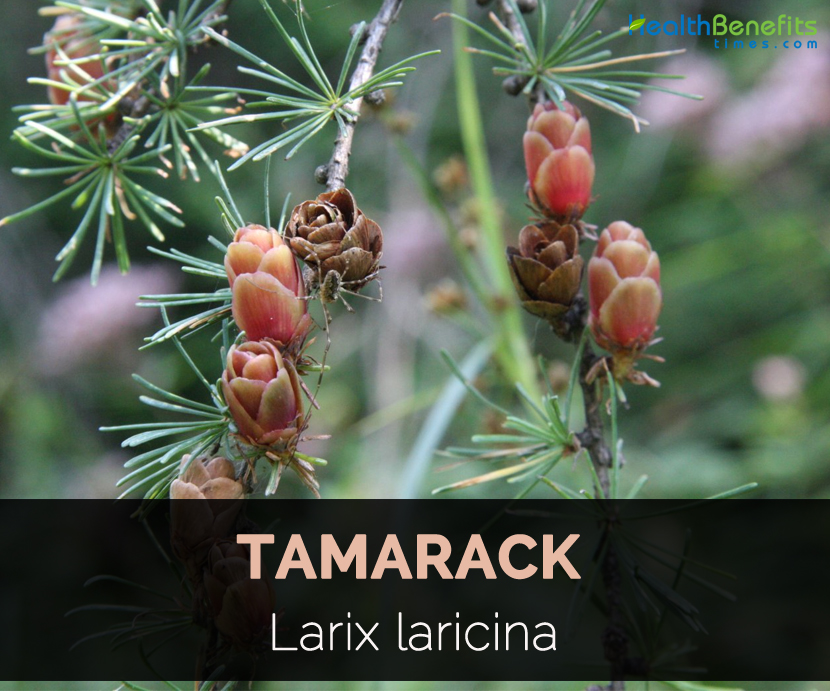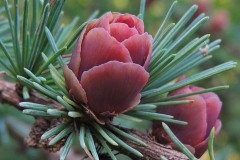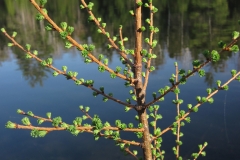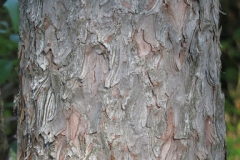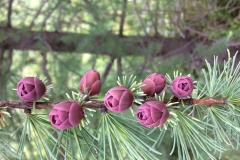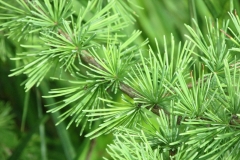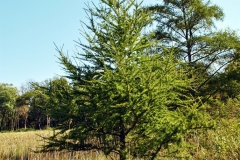| Tamarack Quick Facts | |
|---|---|
| Name: | Tamarack |
| Scientific Name: | Larix laricina |
| Origin | Native to Canada, from eastern Yukon and Inuvik, Northwest Territories east to Newfoundland |
| Name | Tamarack |
|---|---|
| Scientific Name | Larix laricina |
| Native | Native to Canada, from eastern Yukon and Inuvik, Northwest Territories east to Newfoundland, and also south into the upper northeastern United States from Minnesota to Cranesville Swamp, West Virginia; there is also an isolated population in central Alaska. |
| Common/English Name | Black Larch, American Larch, Hackmetack, Salisb, Alaska larch, Red larch |
| Bark | Smooth gray |
| Buds | Rounded, glossy and reddish brown |
| Medicinal part | The inner bark |
Leaf
Deciduous, flat needle, light green, appear in spirals on spur shoots after first year, ¾ to 1 inch long, turn yellow in the fall.
Flower
Species is monoecious; males yellowish, small and round in clusters near branch tips; females reddish-brown, numerous scales, egg-shaped.
Fruit
Small, ¾ to 1 inch, light brown, egg-shaped cone; persist throughout the winter.
Twig
Slender, light brown, numerous short, spur branches.
Bark
Rough, small scaly patches, grayish brown to reddish brown.
Uses
Because of its astringent and gently stimulating qualities the inner bark is especially useful for melancholy, often caused by the enlarged, sluggish, hardened, condition of the liver and spleen with inactivates various other functions of the metabolism. For domestic use in emergencies, or long-standing bleeding of any kind, in lungs, stomach, bowels, or too profuse menstruation. Also for diarrhoea, rheumatism, bronchitis, asthma and poisonous insect bites. J. Kloss in “Back to Eden”, recommends the weak tea as an eye wash and the warm tea dropped in the ear to relieve earache. A decoction of the bark, combined with Spearmint (Mentha viridis), Juniper (Juniperus communis), Horse radish (Cochlearia armoracia), and taken in wineglassful doses has proven valuable in dropsy.
Dose
As a tea, 1 teaspoonful of the inner bark to 1 cupful of boiling water; steep 30 min.
Externally
As a wash used to cleanse ulcerated sores of long standing, if the condition has progressed to the bone, combine with Comfrey (Symphytum officinale) fresh or dried (taken internally too). As a poultice, dress often and continue until new skin seals the areas. Also used for haemorrhoids as a salve, or sitz-bath.
Russian Experience
Listvennitza Sibirsky, Larix iberia (Tamarack), grows 150 ft. tall in Siberia and the far east. The very wide branching tree is one of the most beautiful and magnificent to adorn their countryside. Turpentine of Larix, known in Russia as venetian terpentain, is one of the by-products.
Externally
The oil in compound is used for rheumatism, neuralgia, gout; new twigs and bark made into an antibiotic and antiseptic is used as an inhalant steam for catarrh of the lungs, abscesses, gangrene of the lungs, throat, bronchitis. Also of help to kidney and bladder.
Medicinal uses
- Tea made from bark is used as diuretic, alterative, tonic and laxative.
- Use it for treating anemia, jaundice, colds, rheumatism and skin problems.
- Use it as a gargle for treating sore throats and apply it as a poultice for sores, swellings and burns.
- Apply the poultice of boiled inner bark to wounds for treating infections, burns, deep cuts and frostbite.
- Chew the resin for indigestion.
- Use it for treating piles and diarrhea.
Culinary uses
Inner bark can be scraped, dried and ground into a meal to be mixed with other flours.
References:
https://www.itis.gov/servlet/SingleRpt/SingleRpt?search_topic=TSN&search_value=183412#null
https://pfaf.org/user/Plant.aspx?LatinName=Larix+laricina
https://web.uri.edu/rhodeislandwoods/files/Larix-laricina.pdf
https://dc.cod.edu/horticulture-2242-larix-laricina/larix-laricina.pdf
https://plants.usda.gov/plantguide/pdf/pg_lala.pdf


